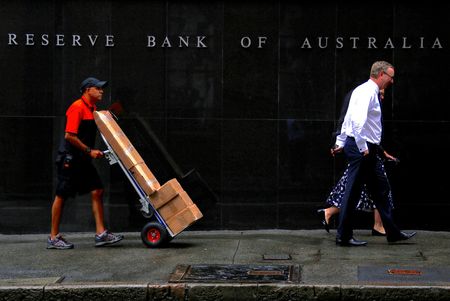By Wayne Cole
SYDNEY (Reuters) -Australia’s central bank on Tuesday surprised markets by lifting interest rates by a smaller-than-expected 25 basis points, saying they had already risen substantially, although it added that further tightening would still be needed.
Wrapping up its October policy meeting, the Reserve Bank of Australia (RBA) raised its cash rate to a nine-year peak of 2.60%, the sixth hike in as many months which included four outsized moves of 50 basis points.
The bank had recently flagged a possible slowdown in the pace of hikes at some point. But markets had wagered it would go by half a point this week in part due to an aggressive Federal Reserve rate hike last month.
“The cash rate has been increased substantially in a short period of time,” RBA Governor Philip Lowe said in a statement.
“Reflecting this, the Board decided to increase the cash rate by 25 basis points this month as it assesses the outlook for inflation and economic growth in Australia,” he added. “The Board expects to increase interest rates further over the period ahead.”
Investors took the local dollar down 0.8% to $0.6465, toward its recent 2-1/2 year trough of $0.6364. [AU/INT]
Interest rate futures jumped as the market priced in a likely lower peak for rates, under the 4.0% previously expected, while three-year bond futures were down a steep 42.5 ticks at 96.750.
“It sends quite an important signal about the pace of future hikes … when you drop down a gear now, while most of the globe is still doing much larger hikes,” said Su-Lin Ong, head of Australian economics at RBC Capital Markets.
“The discussion now is going to be zero or 25 for the next few meetings.”
GLOBAL UNCERTAINTY
Markets have been taking their cue from uber-hawkish central banks abroad, where hikes of 75 or 100 basis points have become almost common.
However, Lowe cited a deteriorating outlook for the global economy as a major uncertainty, along with the response of Australian households to sharply higher borrowing costs.
The cautious tone was echoed by Treasurer Jim Chalmers in a news conference after the RBA’s move.
“The weight of opinion around the world is that the global situation has gotten much worse, even in the last few weeks,” he said.
Chalmers is finalising his first annual budget for release later this month after winning election back in May, and is warning it will contain some tough choices on spending.
The rate hikes already delivered will add around A$800 a month in repayments to the average A$620,000 mortgage, a deadweight for a population that holds A$2 trillion ($1.3 trillion) in home loans.
House prices have also slid for five months in a row, led by big drops in Sydney and Melbourne.
That drop combined with losses in pension funds cut A$484 billion from household wealth in the three months to June, and an even larger decline is likely in the September quarter.
So far, consumer spending has held up well, thanks in part to a strong labour market where unemployment is near its lowest in five decades at 3.5%.
Data out last week showed there were almost as many job vacancies as unemployed, while ANZ job ads dipped only slightly in September to remain a sizable 56% above pre-pandemic levels.
“The fact that job ads and other leading indicators of Australia’s labour market are still so strong suggests the RBA may have to take the cash rate further into restrictive territory than we currently expect to slow demand growth,” said ANZ senior economist Catherine Birch.
($1 = 1.5442 Australian dollars)
(Reporting by Wayne Cole; Editing by Sam Holmes, Ana Nicolaci da Costa and Edmund Klamann)





